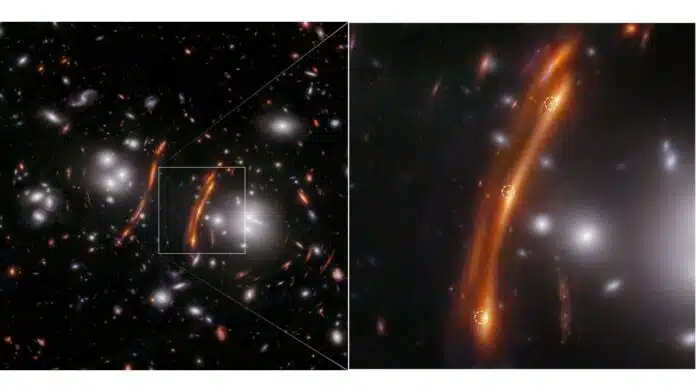
By Pranjal Malewar 2 Oct, 2024
Collected at: https://www.techexplorist.com/webb-scientists-discovered-lensed-supernova/90613/
Astronomers globally are actively researching the Hubble constant, which measures the universe’s expansion rate, using data from both ground and space observatories. The James Webb Space Telescope has played a vital role, recently confirming earlier measurements by the Hubble Space Telescope through the analysis of Cepheid variables and Type Ia supernovae as distance markers.
Researchers are now enhancing the precision of the Hubble constant by measuring gravitationally lensed supernovae. Brenda Frye from the University of Arizona leads this initiative following the James Webb Space Telescope’s discovery of three points of light in a distant galaxy cluster. The team, dubbed Supernova H0pe, uses gravitational lensing effects to gain new insights into the Hubble constant.The video player is currently playing an ad. You can skip the ad in 5 sec with a mouse or keyboard
The team’s inquiry began with a question: “What are those three dots that weren’t there before? Could that be a supernova?”
Frye said, “The points of light, not visible in 2015 Hubble imaging of the same cluster, were obvious when the images of PLCK G165.7+67.0 arrived on Earth from Webb’s Guaranteed Time Observations of the Prime Extragalactic Areas for Reionization and Lensing Science (PEARLS) ‘Clusters’ program.”
“The team notes that the question was the first to come to mind for a good reason: ‘The field of G165 was selected for this program due to its high rate of star formation of more than 300 solar masses per year, an attribute that correlates with higher supernova rates.”
Initial analyses confirmed that the three dots correspond to a rare Type Ia supernova, the explosion of a white dwarf star. This type is known as a “standard candle” due to its predictable intrinsic brightness. Additionally, it is gravitationally lensed, enhancing its visibility and usefulness for research.
Gravitational lensing plays a vital role in this experiment. The lens, consisting of a galactic cluster situated between the supernova and us, bends the supernova’s light into multiple images. This phenomenon is akin to a trifold vanity mirror, which shows three different images of a person. In the Webb image, the middle image of the supernova was flipped compared to the other two, illustrating a ‘lensing’ effect as predicted by theory.
To achieve three images, the light from the supernova traveled along different paths, resulting in it being observed at three distinct times during its explosion. In the trifold mirror analogy, each mirror showed a different moment: one with a person lifting a comb, another with hair being combed, and the third with the comb being put down.
These trifold supernova images are significant because the time delays, the supernova’s distance, and gravitational lensing effects can help determine the Hubble constant (H₀). This particular supernova was named SN H0pe, as it provides hope for astronomers to better understand the universe’s changing expansion rate.
To further explore SN H0pe, the team wrote a Webb Director’s Discretionary Time (DDT) proposal that was evaluated by science experts in a dual-anonymous review and recommended by the Webb Science Policies Group for DDT observations.
Simultaneously, they obtained data at the MMT, a 6.5-meter telescope on Mt. Hopkins, and the Large Binocular Telescope on Mt. Graham, both in Arizona. The team observed both observations and confirmed that SN H0pe is anchored to a background galaxy that existed 3.5 billion years after the Big Bang, well behind the cluster.
SN H0pe is among the most distant Type Ia supernovae observed. A team member confirmed its Type Ia classification by analyzing the James Webb Space Telescope’s light spectrum and measuring its colors’ evolution over time.
Seven subgroups provided lens models for the 2D matter distribution of a galaxy cluster. Each model was evaluated based on its ability to predict time delays and supernova brightness relative to measured values, ensuring unbiased results through a ‘live unblinding’ event.
The team reported the Hubble constant as 75.4 kilometers per second per megaparsec, with uncertainties of +8.1 and -5.5. This is only the second measurement of the Hubble constant using this method; the first is with a standard candle. The lead investigator of the PEARLS program highlighted its significance for understanding this fundamental cosmic parameter.
The results align with local universe measurements but show some tension with values from the early universe. Upcoming Webb observations in Cycle 3 aim to refine these uncertainties for better constraints on H0.

Leave a Reply